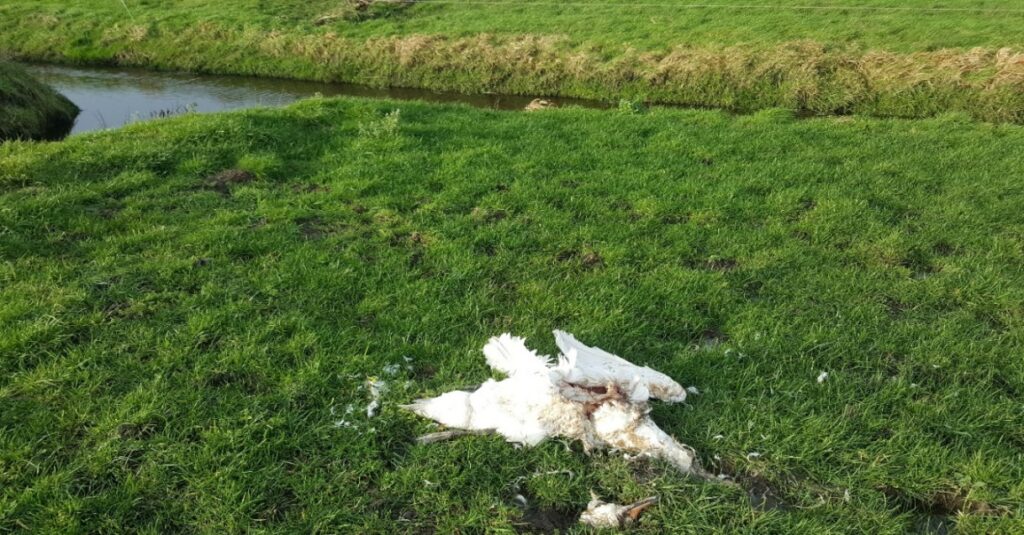No evidence of bird flu in dead mute swans
In 2015, 11 dead mute swans were submitted to the Dutch Wildlife Health Centre (DWHC) for post-mortem investigation. Whilst the cause of death of these birds varied, they were all negative for avian influenza virus.
The mute swan (Cygnus olor) was the focus species for the DWHC wildlife monitoring program in 2015. In previous years, results from post-mortem investigations performed at the DWHC had shown a range of inflammatory conditions for which the causative pathogen could not be identified; in order to shed more light on the general health statuts of these birds in the Netherlands and possibly identify the main infectious challenges the DWHC aimed to post-mortem 40 birds in 2015. All 11 mute swans received over this period were tested for the presence of avian influenza virus as this species is important in routine screening for avian influenza in wild bird populations.
Swan cadavers often too decomposed for post-mortem

Example of a cadaver that is unsuitable for submission (Photo: Jolianne Rijks).
In 2015 the number of mute swans received by the DWHC fell far short of the 40 birds that had been proposed as being necessary to give a representative snapshot of population health. It transpired that many of the cadavers found were deemed to be unsuitable for submission due to an advanced state of decomposition. The large size of these birds also presented a hurdle for some people who found a cadaver but were unable to carry / transport it appropriately.
Cause of death
The 11 swans investigated in this study were submitted from four provinces: South-Holland (4), North-Holland (4), Utrecht (2) and Flevoland (1). Microscopic examination of tissues from these birds was often impaired of impossible due to moderate (2) or advanced (5) decomposition (autolysis). Three birds appeared to have died from injuries consistent with trauma although mild inflammatory conditions were also found in two of these birds. Six swans (either reported or submitted for post-mortem) appeared to have died from starvation but the cause of this was not identified. Three of the emaciated birds, all juveniles, also had enlarged livers and in two other emaciated juveniles moderate (i.e. sub-optimal) mineralisation of the skeleton was seen, possibly indicating some sort of dietary insufficiency (microscopic exam was not performed in these cases). In the other emaciated animal no other abnormalities were observed. Other post-mortem findings included a swan with a stomach bleed and severe diarrhoea and another animal with esophageal and liver inflammation.
| Age | Autolysis | Cause of death | Other findings | Month | Province |
| juvenile | moderate | unknown | diarrhoea, stomach bleed | Jan | South-Holland |
| adult | none | trauma | – | Apr | Flevoland |
| adult | none | starvation | – | Apr | North-Holland |
| juvenile | advanced | starvation | moderate (sub-optimal) skeletal mineralisation | Jun | Utrecht |
| juvenile | advanced | starvation | moderate (sub-optimal) skeletal mineralisation | Jun | Utrecht |
| juvenile | advanced | starvation | enlarged liver | Jul | North-Holland |
| juvenile | advanced | starvation | enlarged liver | Jul | North-Holland |
| juvenile | advanced | starvation | enlarged liver | Jul | North-Holland |
| adult | none | trauma | stomach inflammation (probably parasitic), mild liver inflammation | Sept | South-Holland |
| adult | moderate | unknown | esophageal (and possibly liver) inflammation. | Oct | South-Holland |
| juvenile | none | trauma | mild liver inflammation, intestinal and lung parasites | Dec | South-Holland |
Avian influenza
Mute swans are very sensitive to highly pathogenic (lethal) strains of H5N1 avian influenza virus and for this reason they are suitable as sentinels for the presence of infection. Indeed EU regulations support the testing of this species as part of avian influenza monitoring programs. In the Netherlands, these tests are perofmed at the Central Veterinary Institute on material from mute swan cadavers. In 2015, all 11 mute swans, the DWHC focus species for that year, were negative for the highly pathogenic H5N1, and other strains of the avian influenza virus.
Keep reporting dead birds
Whilst 2016’s focus species is the green finch, the DWHC will continue monitoring the health status of wild mute swans in the Netherlands and investigating the pathogen(s) that causes / caused the inflammation seen in previous post-mortems on these birds. Please help by reporting finding a dead bird via the submission form on our website. This will also contribute to the Europe-wide avian influenza surveillance project; in addition to mute swans, the EU recommends the testing of a range of other birds, many of which are also found in the Netherlands, including ducks, geese, swans, great crested grebes, herons, seagulls, waders, coots and other species of marsh and wetland birds, members of the crow family and birds of prey.



